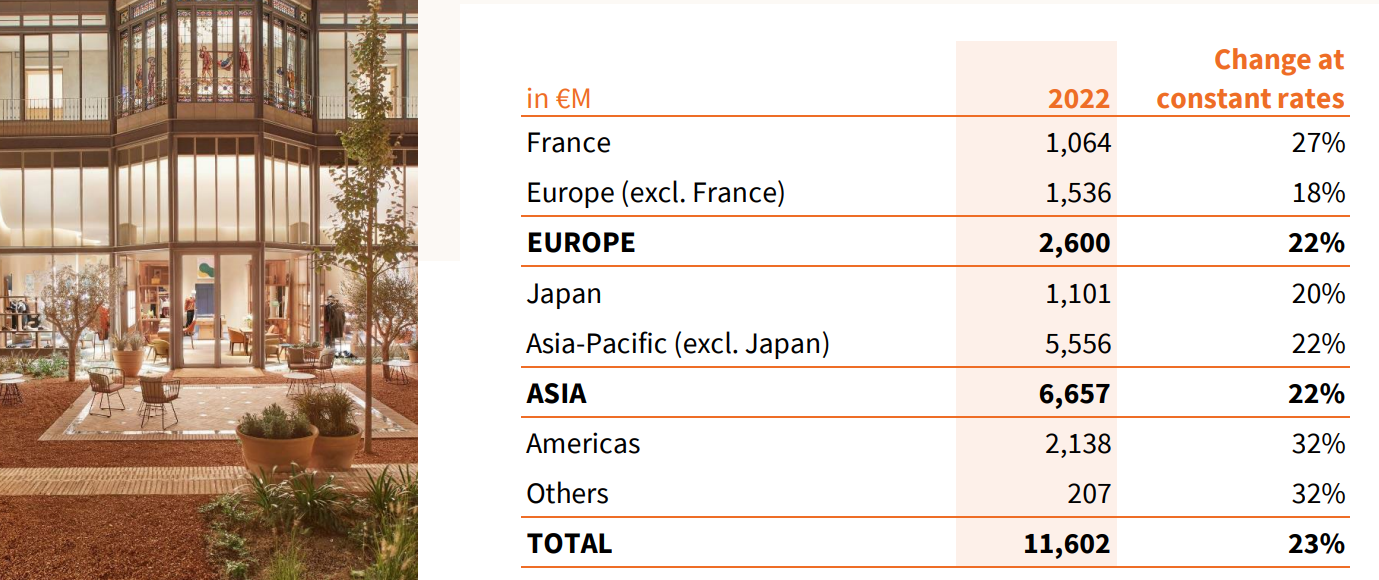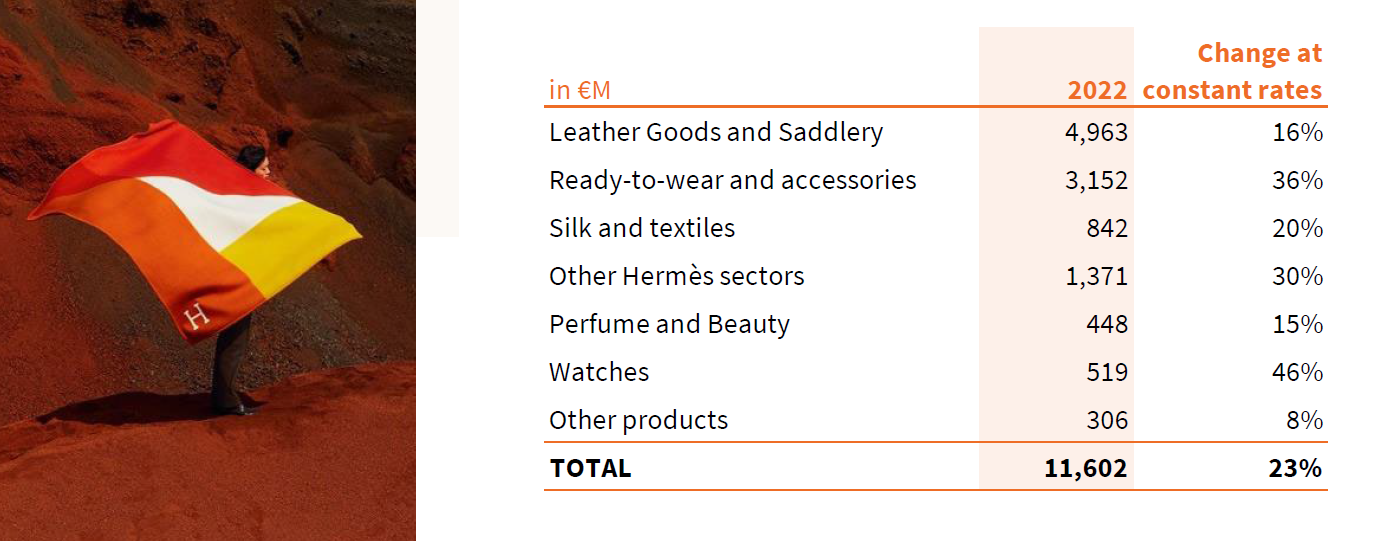Hermes Marketing Strategy and Campaigns
Intensive Case Study on Marketing Strategy of Hermes – 2023 Update
Hermes is among the brands which have achieved great success. Since its founding in the 1890s, the company has established an international luxury clothing company in France.
The company’s products and services are recognized internationally as the leading luxury brand with a reputation for quality and luxury.

Image: Hermes Sales CAGR
Case studies of Hermes describe their business from a marketing standpoint. This consists of learning about the Hermes brand, its 4Ps, marketing mix strategies, marketing and campaign strategies, and digital presence. Let’s start with learning the companies’ story for today.
Hermès Paris: a Company Founded in 1837
Hermes was an elegant French brand that was founded in 1837. True to a tradition of business models rejecting mass production, the company is well known as an industry leader in high-quality production carried out manually and in specialized France workshops.
It offers a range of luxurious goods that are divided into 14 products such as watches, fragrance jewelry, and ties. But today we’ll look at celebrity purses. No the usual ones (which are usually less than $1,000). These are the exclusive ones that drive people insane.

The horse-drawn Carriage Logo: Beginnings and Rise
Thierry Hermes founded Hermès in 1837. The company was initially an elegant carriage company that served noblemen and evolved over time to manufacture bags, scarves, t-shirts, and sanitary products. The motto of this family has been continued ever since. Hermès only advertises its Scarves and Clothing line, a far more affordable category than paid advertising.
With the right marketing strategy, Hermès has created a €36 Billion empire. Not just that, the brand has customers spending sleepless nights buying their products.
The Target Audience of Hermes
Hermès is a luxury fashion brand known for its high-quality craftsmanship, exclusive designs, and exceptional materials. The brand’s target customers can be categorized into different customer personas, each with unique characteristics, preferences, and needs.

Image: Hermes target markets by geography
Here are three primary customer personas for Hermès:
The Affluent Professional
Demographics:
This customer is typically between 35 and 60 years old, with a high income and a successful career in industries such as finance, law, or technology. They have a college degree or higher and likely reside in affluent urban or suburban areas.
Psychographics:
They value quality, exclusivity, and craftsmanship and are willing to pay a premium for luxury goods. They have a sophisticated taste and prefer timeless, classic styles that showcase their success and status. They are well-traveled and appreciate the cultural significance of Hermès as a global luxury brand.
Buying behavior:
This customer regularly purchases Hermès products, such as leather goods, silk scarves, and ties. They may also invest in high-ticket items like Birkin and Kelly bags as a symbol of status or as an investment.
The Fashion Forward Trendsetter
Demographics:
This customer is typically between 25 and 45 years old, with a high disposable income. They work in creative industries such as fashion, design, or entertainment and are often seen as influencers among their social circles.
Psychographics:
They are fashion-conscious and always on the lookout for the latest trends and styles. They appreciate the exclusivity and prestige associated with Hermès, but also value the brand’s unique collaborations with contemporary artists and designers.
Buying behavior:
This customer frequently purchases limited edition and seasonal items, such as fashion accessories, ready-to-wear collections, and special edition bags. They may also share their purchases on social media, generating buzz and helping to maintain Hermès’ status as a desirable luxury brand.
The Aspirational Shopper
Demographics:
This customer is typically between 20 and 40 years old, with a moderate income and a strong desire to elevate their social status. They may be early in their careers, working in industries such as marketing, education, or retail.
Psychographics:
They aspire to live a luxurious lifestyle and are willing to save and invest in a few high-quality, status-enhancing items. They admire the craftsmanship, heritage, and reputation of Hermès and see owning their products as a sign of success.
Buying behavior:
This customer may save up to purchase one or two iconic Hermès items, such as a silk scarf, a leather belt, or a small leather good. They may also shop during sales or at second-hand luxury stores to find more affordable options.
These customer personas represent different segments of Hermès’ target market, each with distinct preferences, motivations, and buying behaviors.
The brand’s ability to cater to these diverse personas is one of the reasons for its enduring success in the luxury fashion industry.
Hermes targets high-end luxury consumers who value quality, exclusivity, and craftsmanship. The brand’s target customers are typically high-net-worth individuals who are willing to invest in high-end luxury products that are crafted with the utmost attention to detail and quality.
Hermes’ target markets are primarily in developed countries, particularly in Europe and North America. The brand has a strong presence in France, where it is headquartered, as well as in other European countries such as Italy and the United Kingdom. Hermes also has a significant presence in North America, particularly in the United States.
In addition to its core target market of high-end luxury consumers, Hermes has also expanded its reach to appeal to a broader audience. The brand offers a range of products at different price points, including its perfumes and accessories, which are more accessible than its iconic leather goods.
This strategy allows the brand to appeal to a wider customer base while maintaining its position as a symbol of luxury and exclusivity.
Hermes also targets younger consumers through its collaborations with other brands and its use of social media. The brand has partnered with high-end technology companies such as Apple to create exclusive products that appeal to younger, tech-savvy consumers.
Additionally, Hermes’ social media presence allows it to reach younger consumers who may not have been familiar with the brand before.
Overall, Hermes’ target customers are high-end luxury consumers who value quality, exclusivity, and craftsmanship. The brand’s target markets are primarily in developed countries, particularly in Europe and North America, and the brand has expanded its reach to appeal to a broader audience while maintaining its position as a symbol of luxury and exclusivity.
Influencer Marketing: Quality and Brand Fit Over Quantity
Hermès’ two iconic bags names Birkin and Kelly are named after influential people. It is now becoming an incredibly common practice in luxury products today. For example, there are Mulberry’s ‘Alexa’ shoes named after fashion icons, and ‘I’ girl Alexa Chung and Louboutin shoes named Kate after Super Model Kate Moss. Hermès was among the early founders. Hermes’s muses have not been only megastars. Rather than picking Marilyn Monroe, they chose the famous singer. It would be a bad decision not only in hindsight.
Word of Mouth: Owning the Hermès Bag To Belonging
There was a luxury concept when we saw the Hermès Bags. Hermès will no longer need ad campaigns in these stores because of its investment in its customer relations. It’s word-of-mouth that really helps Hermes achieve success. The purses are favored by celebrities and wealthy people around the world. Stylish locking and signature shape make a statement within wealthy circles. If someone in your family already owned Birkin or Kelly, you would probably have a better chance.
What is Hermès’s Marketing Strategy?
Founded in 1837 by Thierry Hermes, this company was founded as a harness manufacturing workshop in Paris. Nonetheless, over time the demand grew to meet the demands of various generations. Today these brands are spread across a large network of stores. To maintain its position and give exclusive access to its audience the company employs certain advertising strategies. Hermes focuses its marketing campaign on identifying favorable factors for the market and its products.

Hermes is a brand that has maintained a consistent and cohesive marketing strategy throughout the years. This strategy focuses on preserving the brand’s identity as a symbol of luxury and elegance while also ensuring that its products remain relevant to changing consumer tastes and trends.
One of the key elements of the Hermes marketing strategy is the brand’s branding and positioning. Hermes is known for its classic and timeless designs that are synonymous with luxury, sophistication, and exclusivity. This positioning has been maintained by the brand through its products, advertising campaigns, and collaborations.
Hermes’ target audience is also an important consideration for the brand’s marketing strategy. The brand targets high-net-worth individuals who appreciate the quality, exclusivity, and craftsmanship of luxury goods.
This target audience is reached through a range of marketing channels, including digital and print media, as well as events and collaborations.
Hermes’ use of social media is also a vital part of its marketing strategy. The brand uses social media to showcase its products, brand story, and collaborations. The use of influencer partnerships and collaborations with other brands is also a key component of Hermes’ marketing strategy.
Hermes has collaborated with high-end brands such as Apple, and the brands have created a limited-edition Apple watch for Hermes customers.
The Hermes marketing strategy is cohesive, consistent, and focused on maintaining the brand’s identity as a symbol of luxury and elegance while also ensuring that its products remain relevant to changing consumer tastes and trends.
The brand’s target audience, use of social media, and collaborations have played a significant role in the success of its marketing efforts.
Place and Distribution Strategy of Hermes
Hermes operates its network globally and has expanded its operations throughout Asia and Asia-Pacific over the past decade. The Hermes product is distributed through an omnichannel platform for the sale. There are approximately a quarter of them in more than 40 major and popular nations. Hermes capitalizes on its potential for global sales and has created a strong brand presence. The Internet is able to be localized to help customers pick the language and the content that best meets
Scarcity Marketing: The up to 6 years waiting list
There is no way to talk about luxury marketing without examining the concept. Hermes knows the strategy to sell scarce goods. Using these methods, manufacturers can increase demand by making the demand for products perceived as limited. But Hermes goes further! The brand doesn’t reveal what bag the company makes every month. When you want Hermès bags you can’t have guarantee that their colors, exterior and interior will suit you exactly. Or the number of days you have left before your suitcase arrives. Some of the bags arrive in eight to 9 months while some are waiting a year. Naturally, they do offer standard designs.
HERMEs Marketing MIX
The marketing mix, also known as the 4 Ps (product, price, promotion, and place), is a framework used by marketers to create a comprehensive and cohesive marketing strategy.
Here is an overview of the marketing mix for Hermes:
Product:
Hermes offers a range of luxury products, including leather goods, fashion accessories, perfumes, and ready-to-wear clothing. The products are known for their quality materials, exquisite craftsmanship, and timeless designs. The brand focuses on creating exclusive, high-end products that appeal to a discerning customer base.
Price:
Hermes products are priced at a premium, reflecting the brand’s position as a symbol of luxury and exclusivity. The brand’s pricing strategy is based on the value of its products, with a focus on quality and craftsmanship rather than mass-market appeal.
The Luxury industry provides examples of successful brands at exorbitant prices. The image must always remain impeccable at the same rate of production. Hermes is an internationally famous and largest brand synonymous with opulence and premium goods and services. Although Hermes’ high prices aren’t new, its most expensive luggage bag has recently drawn the attention of its consumers with prices up to $39,000.
Promotion:
Hermes uses a range of marketing channels to promote its products, including print and digital advertising, social media, influencer partnerships, and collaborations with other brands. The brand’s promotion strategy focuses on celebrating its heritage and craftsmanship, while also appealing to changing consumer tastes and trends.
Place:
Hermes products are sold in the brand’s own retail stores, as well as in high-end department stores and luxury boutiques around the world. The brand’s retail stores are designed to reflect its exclusive and sophisticated image, with a focus on creating a luxurious and memorable shopping experience for customers.
Overall, the Hermes marketing mix is focused on creating a cohesive and exclusive brand image that reflects the quality, craftsmanship, and sophistication of its products.
The brand’s marketing strategy is designed to appeal to a discerning customer base that values luxury, exclusivity, and timeless design.
What is the Hermes Product Strategy
Hermes’ product strategy focuses on offering high-end, exclusive, and timeless products that are crafted with the utmost attention to detail and quality. The brand is known for its iconic leather goods, including its Birkin and Kelly bags, as well as its silk scarves and fashion accessories.

Image: Hermes product portfolio
One of the key elements of Hermes’ product strategy is the brand’s commitment to craftsmanship and quality materials. Each product is created by skilled artisans who use traditional techniques to ensure the highest level of quality and attention to detail.
The brand’s leather goods, for example, are crafted from the finest leather and are meticulously crafted to ensure that each piece is unique and of the highest quality.
Another element of Hermes’ product strategy is its focus on exclusivity. The brand creates limited-edition products and collaborates with other luxury brands to create unique and exclusive products that appeal to a discerning customer base.
These exclusive products help to maintain the brand’s position as a symbol of luxury and exclusivity.
Hermes also offers a range of ready-to-wear clothing and accessories that reflect the brand’s timeless and sophisticated style. The brand’s clothing is crafted from high-quality materials and features classic designs that are meant to be worn for years to come.
Overall, Hermes’ product strategy is focused on offering high-end, exclusive, and timeless products that reflect the brand’s commitment to craftsmanship, quality materials, and sophistication.
The brand’s products are designed to appeal to a discerning customer base that values luxury, exclusivity, and timeless design.
Lesson 1. The illusion of scarcity
Hermes Marketing teaches us the first lesson in this. This concept provides added perception for consumers. When products are considered scarce people are willing to invest more money to be the only ones who have them. It’s rare but its value grows when it’s difficult to find.
Evidently, possessing mass-manufactured goods does not provide an identical experience to scarce luxury goods. Even in rich celebrities. Hermes Marketing is able to not limit the availability of this material solely on price.
Lesson 2. Price justification
Hermes Marketing Strategy: Pricing Justification. The next lesson from Hermes Marketing is pricing Justification. Remember, a customer is entitled to a price for a service provided that the price is reasonable to them. Producing an ordinary backpack and then adding 1000-per-piece jeans without the branding can never be a bad idea at all. Brand recognition is nothing you can do overnight.
But even if you are using extremely rare quality materials you’re not going to have the ability to justify the cost.
Advertising & Marketing Campaigns of Hermes
A successful marketing campaign allows clients to know the company’s products. These are actions by an organization that impacts their client.
In addition to its marketing strategy, Hermes has also executed successful campaigns that have further strengthened its brand identity and increased its customer base. Hermes campaigns are known for their creativity, exclusivity, and attention to detail.
One of the most successful Hermes campaigns is the “Leather Forever” campaign. The campaign celebrated the brand’s leather goods heritage and craftsmanship, highlighting the brand’s commitment to quality and timeless design. The campaign included a global exhibition that showcased the brand’s leather-making process and its famous Birkin and Kelly bags. The campaign also featured a short film that captured the essence of the Hermes brand and its iconic products. The “Leather Forever” campaign was a tremendous success and received worldwide recognition, increasing the brand’s visibility and attracting new customers.
Another successful Hermes campaign is the “J’aime mon Carre” campaign. The campaign focused on the brand’s iconic silk scarves and showcased the versatility of the product. The campaign featured a range of personalities, including fashion icons, artists, and designers, who styled the scarves in their unique way. The “J’aime mon Carre” campaign was highly successful, creating a buzz around the brand and attracting new customers.
Hermes has also executed successful collaborations with other brands, including Apple and Nike. The brand’s collaboration with Apple resulted in the creation of a limited-edition Hermes Apple Watch that was highly coveted by consumers. The collaboration with Nike resulted in a range of sneakers that combined the quality and craftsmanship of Hermes with the sporty design of Nike.
The success of Hermes’ campaigns can be attributed to the brand’s attention to detail, creativity, and exclusivity. The campaigns celebrate the brand’s heritage and craftsmanship, showcasing the quality and timeless design of its products. Hermes’ campaigns also focus on storytelling and emotion, creating a connection between the brand and its customers.
Compared to other luxury brands, Hermes’ campaigns are unique in their approach and execution. The brand’s campaigns are not only visually stunning but also emotionally engaging, creating a sense of exclusivity and sophistication that resonates with its target audience.
Here is a list of some of the notable Hermes marketing campaigns in its historic evolution:
- “Kelly en Perles” (1938) – A campaign showcasing the iconic Kelly bag adorned with pearls.
- “J’aime mon Carre” (2011) – A campaign celebrating the brand’s iconic silk scarves and their versatility.
- “La Maison des Carres” (2011) – An interactive website that allows customers to explore the world of Hermes scarves.
- “Festival des Metiers” (2011) – A global tour showcasing the brand’s craftsmen and their skills.
- “Leather Forever” (2012) – A campaign celebrating the brand’s leather goods heritage and craftsmanship.
- “Wanderland” (2013) – A campaign showcasing the brand’s travel accessories and exploring the idea of travel as an adventure.
- “The Gift of Time” (2014) – A holiday campaign featuring the brand’s watches and highlighting the idea of time as a precious gift.
- “Hermes Editeur” (2015) – A campaign showcasing the brand’s expertise in fine art and publishing.
- “Hermes Horse Exhibitions” (2015) – A campaign celebrating the brand’s equestrian heritage and its relationship with horses.
- “Hermesistible” (2016) – A campaign celebrating the brand’s playful and whimsical side, featuring vibrant colors and unexpected designs.
- “Hermes Silk Mix” (2018) – A campaign showcasing the versatility of Hermes silk scarves and their ability to be styled in different ways.
- “Hermes Beauty” (2019) – A campaign celebrating the launch of the brand’s beauty line, featuring a range of makeup and skincare products.
- “Hermes Upcycling” (2020) – A campaign highlighting the brand’s commitment to sustainability and upcycling, featuring limited-edition products made from upcycled materials.
- “Hermes H08” (2021) – A campaign introducing the brand’s new line of watches, featuring a sporty design and modern aesthetics.
In conclusion, Hermes’ campaigns have played a significant role in strengthening the brand’s identity, increasing its customer base, and maintaining its position as a symbol of luxury and elegance. The success of these campaigns can be attributed to the brand’s attention to detail, creativity, and exclusivity, as well as its ability to tell compelling stories and create emotional connections with its customers.
Relationship Marketing: Making the customer sell to Hermès instead
Hermes makes customers want to sell its products through a combination of exclusive, high-end products and exceptional customer service. By creating limited-edition, exclusive products that are crafted with the utmost attention to detail and quality, Hermes creates a sense of exclusivity and desirability around its products.
Additionally, Hermes provides a luxurious and personalized shopping experience at its retail stores, with a focus on creating a memorable experience for customers. This exceptional customer service, combined with the brand’s commitment to quality and exclusivity, creates a sense of loyalty and desire among customers that can lead them to promote and sell the brand to others.
Additionally, Hermes’ collaborations with other high-end brands and partnerships with social media influencers can also help to create buzz and demand for its products among a wider audience. Overall, Hermes’ focus on quality, exclusivity, and exceptional customer service helps to create a sense of desire and loyalty among customers, which can lead them to promote and sell the brand to others.
Digital Marketing Strategy of Hermes
Hermes is a great example of embracing digital marketing. Hermes concentrates on digital marketing. It also has a podcasting system as well as documentary films. Having an enterprise use digital marketing is incredibly profitable for many businesses. Besides this, it also publishes an informational mailing aimed at keeping customers updated about fashion trends. Hermes Documentary Hermes Podcasts Hermes Podcast.
HERMES Future Marketing Plans
As the luxury goods industry continues to evolve, Hermes is likely to make changes to its marketing strategy and campaigns to stay ahead of the competition and appeal to changing consumer preferences.
Here are some potential changes we may see in Hermes’ future marketing plans:
Increased Focus on Digital Marketing
With the growth of e-commerce and social media, Hermes may increase its focus on digital marketing channels. The brand may invest in targeted digital advertising campaigns and social media influencers to reach new customers and maintain its relevance in the digital age.
More Collaborations:
Collaborations have been a key part of Hermes’ marketing strategy in the past, and we can expect to see more collaborations with high-end brands in the future. These collaborations may include partnerships with technology companies or collaborations with other luxury brands to create exclusive limited-edition products.
Sustainability:
As consumers become more conscious of their impact on the environment, we may see Hermes increase its focus on sustainability in its marketing campaigns. The brand may highlight its use of sustainable materials and environmentally-friendly production methods to appeal to socially-conscious consumers.
Personalization:
Personalization has become increasingly important to consumers, and we may see Hermes incorporate more personalization options into its marketing campaigns. The brand may offer personalized products or services, such as custom-made products or personalized packaging, to appeal to individual tastes and preferences.

Innovation:
With the rise of new technologies such as artificial intelligence and virtual reality, we may see Hermes incorporate these technologies into its marketing campaigns to create immersive and engaging experiences for consumers.
It’s important to note that while these changes are potential directions for Hermes’ future marketing plans, the brand’s core values of quality, craftsmanship, and exclusivity are likely to remain the same.
As Hermes continues to evolve its marketing strategy and campaigns, we can expect the brand to maintain its position as one of the most iconic luxury fashion brands in the world.
How Hermes will use EpiProdux Product Strategy Software
EpiProdux is a product strategy software that allows companies to develop, track, and manage their product strategies. The software helps companies identify market opportunities, develop product roadmaps, and track product performance metrics. With EpiProdux, companies can also collaborate on product development and launch activities, enabling cross-functional teams to work together more effectively.

For Hermes, the use of EpiProdux may help the brand to improve its product development process by providing a more structured and data-driven approach to product strategy. The software may help Hermes to identify new market opportunities, develop product roadmaps that align with the brand’s overall strategy, and track key performance metrics to ensure that its products are meeting customer needs and expectations.
Additionally, EpiProdux may help Hermes to streamline its product development and launch processes by improving collaboration across different teams and departments. By using a centralized platform for product strategy and development, Hermes may be able to reduce the time and resources required to bring new products to market.
Overall, the use of EpiProdux may help Hermes to enhance its product strategy and development processes, enabling the brand to continue to offer high-quality, exclusive products that appeal to its discerning customer base.
Conclusion
In conclusion, Hermes is a brand that is synonymous with luxury, quality, and exclusivity. With a rich heritage that dates back to 1837, the brand has established itself as one of the most iconic luxury fashion brands in the world. Hermes’ success can be attributed to its exceptional quality and attention to detail, its commitment to craftsmanship and traditional techniques, and its focus on creating exclusive, limited-edition products that appeal to a discerning customer base.
The brand’s marketing strategy and campaigns reflect these core values, focusing on celebrating the brand’s heritage and craftsmanship while also appealing to changing consumer preferences and trends. Hermes’ marketing mix is designed to create a comprehensive and cohesive marketing strategy that reflects the quality, craftsmanship, and sophistication of its products.
Looking to the future, we can expect Hermes to continue to innovate and evolve its marketing strategy and campaigns to stay ahead of the competition and appeal to changing consumer preferences. The brand’s focus on quality, exclusivity and innovation is likely to remain the same, as it continues to maintain its position as a symbol of luxury and elegance in the fashion industry.
Frequently Asked Questions
What is Hermès’ current marketing strategy?
The company has three main objectives: production quality and an exclusive distribution network. In 1837, the company maintained its values of freedom and craftsmanship savoir-faire, in pursuit of a high level of quality, authentic, and sustainable expansion.
How does Hermès promote its products?
Hermès has implemented its marketing mix with a premium pricing policy to impart exclusivity which is exactly what a luxury consumer seeks and makes no discounts on its products for any special occasion. Exclusiveness will be achieved through the release of limited quantities of the series.
Does Hermès do any marketing?
Hermes is an industry leader in luxury products. Although the world’s biggest brands use marketing in promoting their business plan.
What is the strategy of a marketing campaign?
A marketing strategy describes the company’s plans to attract and engage a potential customer base. Marketing strategy includes company values, a key branding message, information about target audience demographics, and other high-level elements.
What is Hermes known for?
Hermes is known for its luxury goods, including leather goods, fashion accessories, perfumes, and ready-to-wear clothing. The brand is known for its exceptional quality, attention to detail, and exclusivity.
What is the price range of Hermes products?
Hermes products are priced at a premium, reflecting the brand’s position as a symbol of luxury and exclusivity. Prices vary depending on the product, but Hermes’ iconic leather goods and accessories can range from several thousand dollars to tens of thousands of dollars.
What is the most famous Hermes product?
One of Hermes’ most famous products is the Birkin bag, which was created in the 1980s and has since become one of the most iconic luxury handbags in the world. The Kelly bag, another iconic Hermes product, is also highly coveted.
Where can I buy Hermes products?
Hermes products can be purchased at the brand’s own retail stores, as well as in high-end department stores and luxury boutiques around the world. The brand’s retail stores are designed to reflect its exclusive and sophisticated image, with a focus on creating a luxurious and memorable shopping experience for customers.
What is the history of Hermes?
Hermes was founded in 1837 by Thierry Hermes in Paris, France. The brand began as a harness workshop, creating high-quality harnesses and saddles for horses. Over time, the brand expanded its product range to include leather goods, fashion accessories, and other luxury items. Today, Hermes is one of the most iconic luxury fashion brands in the world.
What is Hermes’ commitment to sustainability?
Hermes is committed to sustainability and has implemented various initiatives to reduce its environmental impact. The brand uses sustainable materials and production methods wherever possible, and has implemented programs to reduce waste and energy consumption in its operations. Hermes also partners with organizations to support sustainable development initiatives around the world.
What is the Hermes customer experience like?
The Hermes customer experience is designed to be exclusive and sophisticated, reflecting the brand’s luxury image. Customers can expect a personalized and attentive shopping experience at Hermes retail stores, with a focus on creating a luxurious and memorable experience. The brand’s customer service team is also known for its exceptional service, with a focus on meeting the needs and expectations of its discerning customer base.
Why is Hermès special?
Hermes is special for several reasons:
- Quality: Hermes is known for its exceptional quality and attention to detail in its products. The brand’s leather goods, for example, are crafted from the finest materials and are meticulously crafted by skilled artisans using traditional techniques.
- Craftsmanship: Hermes’ products are created using time-honored techniques that have been passed down through generations of artisans. Each product is crafted with a focus on craftsmanship and attention to detail, making each piece unique and of the highest quality.
- Exclusivity: Hermes’ products are exclusive and limited-edition, with a focus on creating products that are unique and appealing to a discerning customer base. The brand’s iconic Birkin and Kelly bags, for example, are highly coveted and can only be purchased by customers who meet certain criteria.
- Heritage: Hermes has a rich heritage that dates back to its establishment in 1837. The brand’s history and tradition are reflected in its products, which are designed to stand the test of time and be passed down through generations.
- Innovation: While Hermes is known for its tradition and heritage, the brand is also innovative and forward-thinking. The brand has embraced technology and digital marketing and has collaborated with high-end technology companies such as Apple to create exclusive products that appeal to younger consumers.
Overall, Hermes is special because it combines exceptional quality, attention to detail, heritage, exclusivity, and innovation in its products and brand image. These elements have helped the brand maintain its position as a symbol of luxury and exclusivity for over 180 years.


